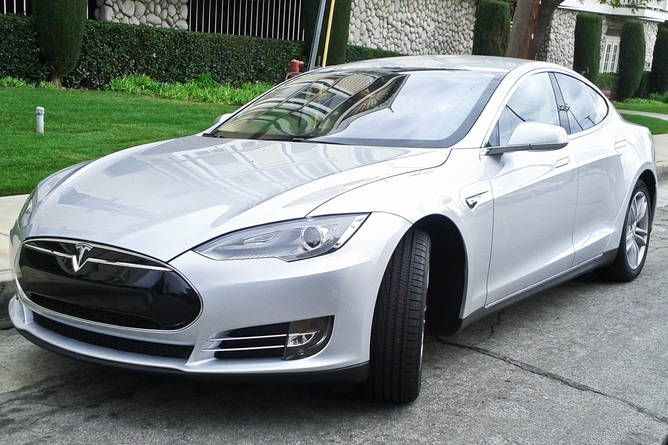Electric vs. Fuel Cell Vehicles: 'Green' Auto Tech Explained

Battery-powered electric cars and hydrogen fuel cell vehicles have both seen advances in their development, and one or both of these technologies may represent the future of "green" automobiles.
Both technologies offer a cleaner alternative to internal combustion engines, and both use electric motors powered by electrochemical devices. But what's the difference between them? For one, electric vehicles use energy stored in a battery, whereas fuel cell vehicles have stored fuel that reacts to produce energy.
The two technologies face unique challenges in achieving widespread adoption, but both are promising, experts say. [Hyperloop, Jetpacks & More: 9 Futuristic Transit Ideas]
"They're not necessarily competing technologies — they're similar and complementary," said Lawrence Drzal, a chemical engineer and materials scientist at Michigan State University in East Lansing.
Electric vehicles
Whereas conventional vehicles burn fuel in an internal combustion engine, battery-powered electric vehicles don't have an engine. Instead, they use energy stored in batteries to power one or more electric motors.
Electric cars have undergone a surge in popularity in recent years, but electric vehicles were already being made in the late 1800s, according to Huei Peng, a mechanical engineer at the University of Michigan who works on the design and control of clean vehicles, including electric cars. The vehicles remained popular until the early 20th century, when they had to compete with mass-produced internal-combustion-engine vehicles.
Sign up for the Live Science daily newsletter now
Get the world’s most fascinating discoveries delivered straight to your inbox.
"After a couple of decades of competition, the internal combustion engine won, mainly because of the limitations of batteries," Peng told Live Science.
Interest in electric vehicles returned during the oil energy crisis of the 1970s and 1980s, but the cars never achieved mass production. Still, electric vehicles have been making a comeback since 2008, with the introduction of fully electric cars such as the Tesla Motors Roadster (and, subsequently, the Model S), and the Nissan Leaf.
Many of today's electric vehicles run on rechargeable lithium-ion batteries — the same kind found in most laptops. These are replacing the cheaper lead-acid batteries used in most older models of electric vehicles. [5 Ways Your Tech Will Go Green in 2015]
Fuel cell vehicles
Fuel cell vehicles are also driven by an electric motor, but instead of being powered by a battery, they create the electricity in an onboard fuel cell, usually using oxygen from the air and stored hydrogen.
"Batteries and fuel cells are quite similar," said Shawn Litster, a mechanical engineer at Carnegie Mellon University in Pittsburgh who works on fuel cell design. The difference is, "with a fuel cell, you're able to decouple energy conversion from energy storage," he said.
Fuel cells use a catalyst to combine two reactants, which generates a flow of electrons (aka electricity). A variety of fuels can be used to support fuel cells, but the most common is hydrogen that is produced from natural gas. When oxygen and hydrogen react, they produce only water and heat, making them "zero-emissions" vehicles (like battery-powered electric vehicles).
"Probably the oldest [commercial] use of fuel cells is in the space program," said Drzal, who works on materials to make vehicles lighter and more fuel-efficient. While NASA could afford to pay virtually any price for them, for consumer vehicles, "you need fuel cells that are not only efficient, but cost-effective," Drzal told Live Science.
Today, two fuel cell vehicles are available on the market: the Hyundai Tucson (ix35 FCEV) and the Toyota Mirai. Currently, there are ten public hydrogen fueling stations in California, one in Connecticut and one in South Carolina, according to the U.S. Department of Energy. And several dozen more are under development in California, Litster said.
Electric vs. fuel cell?
Electric vehicles offer a promising alternative to internal-combustion vehicles because they don't directly burn fossil fuels. They are also capable of producing instant torque and smoother acceleration than conventional cars.
But electric vehicles aren't necessarily more environmentally friendly than conventional combustion vehicles. If the electricity used to charge the electric vehicle comes from a coal power plant, for example, it can be dirtier than even the worst internal-combustion vehicle, Peng said. The same reasoning applies to fuel cells — they're only as clean as the source of the hydrogen they use.
Electric vehicles are also limited by the range they can travel on a single battery charge. For short-distance commuting, this isn't a problem, but longer trips require lengthy periods of recharging. Battery swapping — in which a depleted battery is exchanged for a fully charged one — is one possible solution, and Tesla Motors has begun using this option.
Battery technology has improved dramatically, but "batteries are still too heavy and expensive, and don't have enough energy, which means a shorter range," Peng said. But he added that the price of batteries has come down significantly in the past 10 years.
Fuel cell vehicles don't have the same range limitations as battery-powered vehicles because they can simply store more (hydrogen) fuel. The main disadvantages of today's hydrogen fuel cell vehicles are the lack of sufficient infrastructure for hydrogen refueling, and the cost of the catalysts, Litster said.
Platinum is one of the most commonly used catalysts for fuel cells, but it's very expensive, Litster said. He and his colleagues are working on how to make platinum more efficient, while other researchers are developing catalysts made of lower-cost materials.
While battery-powered electric vehicles may have a head start on fuel cell vehicles, both technologies are advancing rapidly. It will be interesting to see where they are five years from now, Litster said.
Follow Tanya Lewis on Twitter. Follow us @livescience, Facebook & Google+. Original article on Live Science.










